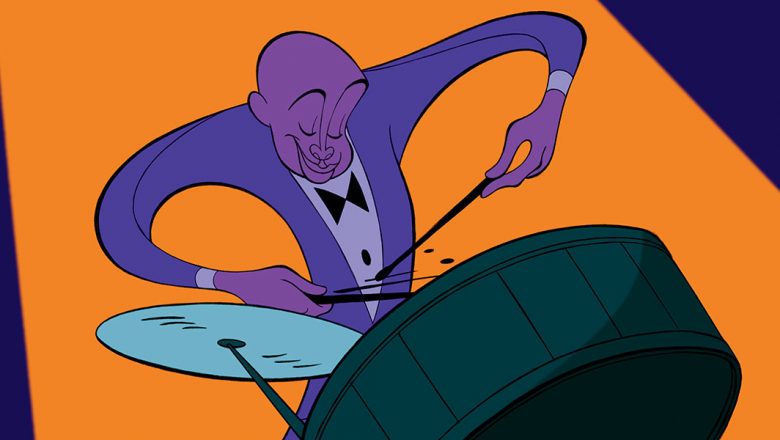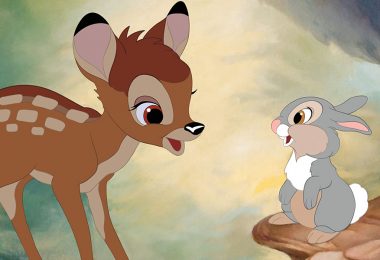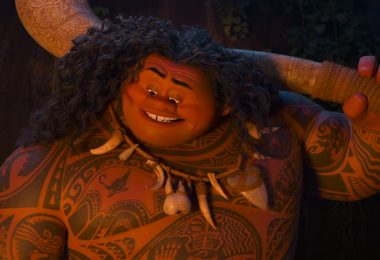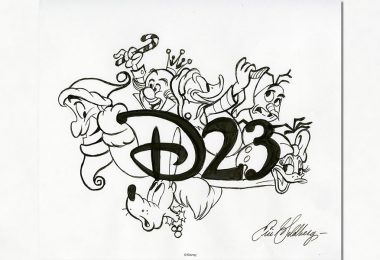By Jocelyn Buhlman
This month, we’re celebrating the 20th anniversary of Fantasia 2000, which invited a new generation of Disney animators to showcase their talents as they visually interpreted classical compositions in the style of 1940’s Fantasia. To celebrate this stunning film’s milestone anniversary, we sat down with supervising director Eric Goldberg and with his wife, Susan Goldberg, who provided art direction for two sequences in the film that Eric directed and wrote: “Rhapsody in Blue” and “The Carnival of the Animals.”
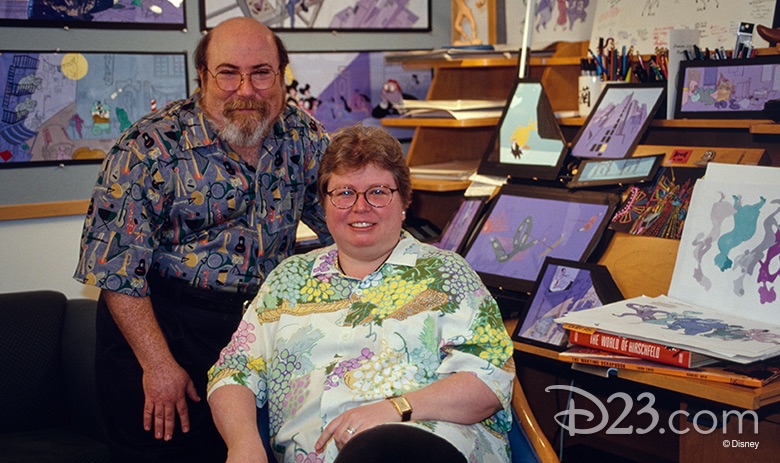
D23, The Official Disney Fan Club: The “Rhapsody in Blue” sequence in Fantasia 2000 was originally planned as a standalone short film—can you share a little bit about how the sequence became part of Fantasia 2000?
Eric Goldberg (EG): What happened was Fantasia 2000 had already started production. I proposed to Roy Disney and Don Ernst a sequence set to “Rhapsody,” and they felt that the music was too modern.
We were making it as a standalone short, but we were also working on Fantasia 2000. There was a screening of the film with 50 percent new stuff and 50 percent from the classic Fantasia, but the classic stuff didn’t really cut well with the new stuff—they’re all great, but there’s a time lag there between the two periods during which they were produced. The lights came up, Roy [Disney] turned around to me and said, “Eric, is ‘Rhapsody in Blue’ going to be ready in time?” I said, “Actually, yes, because we’re on a parallel track.” That’s how it got in.
D23: What inspired you to stylize the sequence like the caricatures of Al Hirschfeld?
EG: Al Hirschfeld was a huge influence on me. I had previously appropriated his style on Aladdin, basing characters on curvilinear drawings like his.
D23: Susan Goldberg (SG): Eric used him for the inspiration on Aladdin for Genie.
EG: When time came to do a “Rhapsody in Blue,” Al came on as our official artistic consultant, which was wonderful. Oh my gosh—to be able to have your work approved by Al Hirschfeld! We showed him the story reel and we showed him Susan’s art direction pieces. He saw those and he went, “First rate!”
It was just a wonderful, wonderful thing to really have him involved. Every now and again you get to work with one of your heroes, and I have been following Hirschfeld since high school, so to actually have a chance to work with him was amazing.
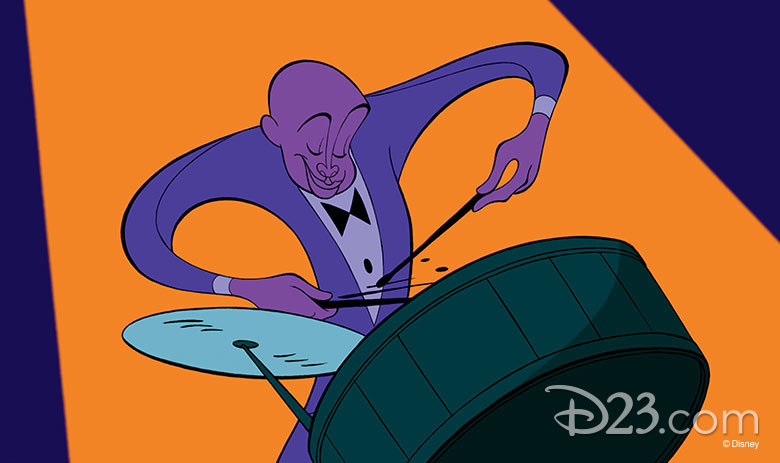
SG: Al came out and did a couple of lectures about his work and about what inspired him and how he approached things. He is truly an interesting guy. One of the most wonderful things he ever said was, “If I need to make a drawing and I don’t have any time, I make a very busy drawing. If I have time, I make a simple drawing because it takes more time,’ and Eric approaches things that way. So, when it came time to do “Rhapsody” and could we do it in Al Hirschfield’s style, I mean, how much more New York can you get?
D23: The hotel in “Rhapsody in Blue” is named “The Goldberg”—are there any other Easter Eggs that fans should watch out for in your sequences?
EG: Tons of them! The layout department took it upon themselves to do things in the spirit of Hirschfeld, who, of course, always hid his daughter’s name, Nina, in his drawings. If you look at a Hirschfeld drawing and there’s a number down by his signature, that’s how many names are hidden in the drawing. He’s genius, the way he has worked these things in. I tried to do that, too. I put a Nina in Duke’s toothpaste tube. There’s a Nina in Margaret’s fluffy collar.
So, the layout department figured, OK, we’ll put all our names in it. Probably the prime prankster in this one was a layout artist named Doug Walker. And he worked “Doug” into everything—I mean, Doug is all over the place. So much so, that when the film premiered, a film critic phoned the studio with this burning question: “Who’s Doug?”
D23: Do you have personal memories of New York that influenced this sequence?
EG: Well, absolutely. First of all, I met Susan in New York City. I met her through a mutual friend and the New York in “Rhapsody” is not unlike the New York that we knew in, say, the early ’80s.
SG: My first job in animation was actually in New York. I had a friend who was working for a commercial company there, and she said, “Well, why don’t you come up? They need a background painter, and I know you do that.” I just love the energy of New York. I liked the architecture—I grew up in a really small town in Florida. So, for me it was like, “Wow!”
EG: This is kind of our love letter to New York. We both loved New York and we’ve had a lot of similar experiences before we even met in New York, particularly New York City, where it’s always so teeming with different individuals who have different needs and wants and sometimes they brush up against the one another.
D23: What about “Rhapsody in Blue” appealed to you from an animation perspective?
EG: It’s always been my favorite piece of classical music. The thing that I love about it is that it has so many colors in terms of mood changes and instrumentation. It’s got a lot of flavors in it, which are advantageous to telling a fairly sprawling story about New York City. Knowing that Roy wanted a plot, we devised a plot for it and certainly things in the music dictated visuals to me. I would hear one piece and think, that sounds like a pile driver! I’d hear another and think, that sounds like car screeching to a halt. When the time came and I could storyboard it, I started connecting the dots and worked those bits into the story.
D23: Some consider “The Carnival of the Animals” to be a sequel to Fantasia’s “Dance of the Hours”—do you agree? Did “Dance of the Hours” inspire this sequence at all?
EG: Well, here’s the funny thing. Tangentially, yes. OK. We never intended it to be that way. What has happened is there is one huge, huge, huge connection to both of them—and that is the late, great Joe Grant. Joe was the one who came up with “The Dance of The Hours,” and he also came up with “Carnival of the Animals.” Originally, when he had done some rough boards on it, he envisioned [the “Carnival of the Animals” sequence] with the ostriches from “Dance of the Hours.” And, I think Michael Eisner was looking at it, and he said, “How about flamingos? We haven’t done flamingos yet.”
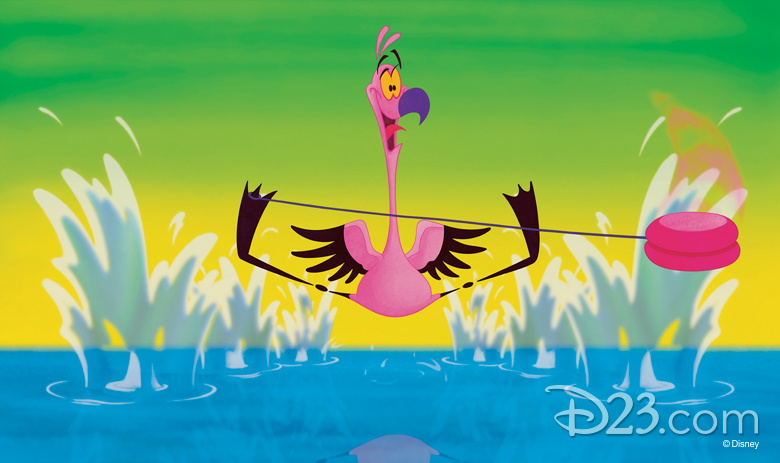
So, Joe changed it to flamingos and that really put a different spin on it. We went to various zoos to study flamingo behavior, and what really came across was that they live by mob rule. When one raises its head, 20 others raise their head. When one looks left, 20 others follow left. And we just thought, OK, the guy with the yo-yo must be the guy who doesn’t want to do that. It’s a story of the conformists vs. the nonconformists, and that gave us our hook.
D23: Do you have a favorite Fantasia 2000 sequence (outside of the two you worked on)?
EG: Oh gosh, I would probably have to say “Firebird Suite.” I think it’s quite beautiful.
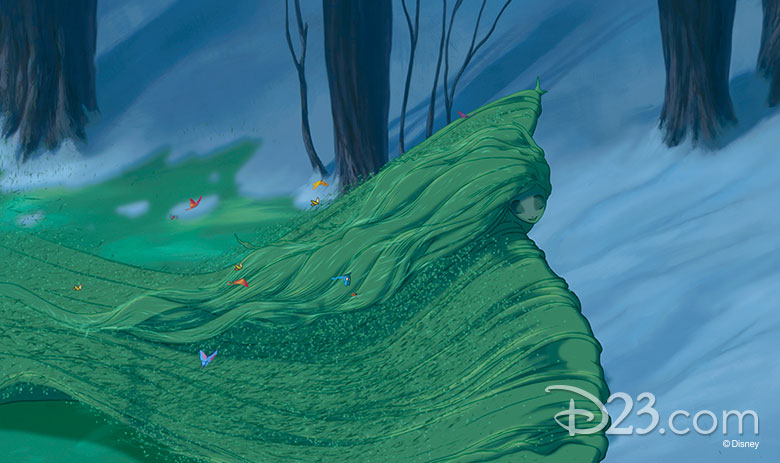
SG: We had offices next to the directors [of “ Firebird Suite”], and we watched them put their hearts and souls into it, and they had a really strong animation crew that worked so hard and did it so well.
EG: I think it’s very inspiring, and very beautiful.
SG: It’s such a powerful piece of music, so I think that’s probably my other favorite outside of ours.
D23: What was it like working together on both “Rhapsody in Blue” and “The Carnival of the Animals”?
SG: We’ve actually worked together a lot, because when Eric had a commercial company, I would do backgrounds, or clean up, or assist in animation or design—whatever they needed. We’ve worked together on everything—we’ve always worked really well together. I respect him tremendously.
We have two daughters: My eldest daughter, Jennifer, is a is a character designer and an art director in animation. My youngest daughter, Rachel, is a costume designer and make costumes for [stop-motion] puppets. Animation runs in the blood. If only I could just get my cats into it!
You can watch “Rhapsody in Blue,” “Carnival of the Animals,” and the rest of the fantastically wonderful sequences in Fantasia 2000 on Disney+.


